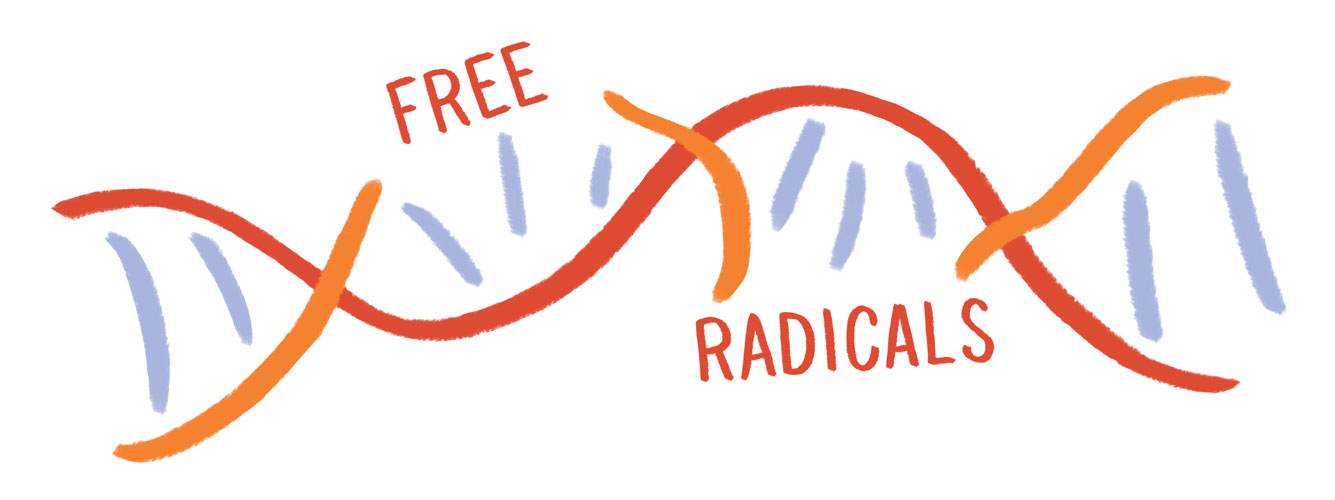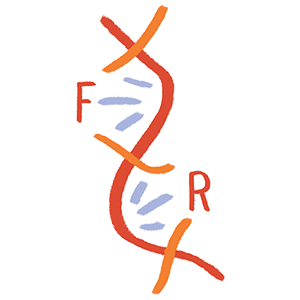
A childhood photograph of the author and her brother is overlaid with images of multiple hands holding a magnifying glass, a pen, and a notepad. These hands represent the profound role of science and medicine in the lives of the two kids. Artwork by Gray Wielebinski .
I spent my school days living under the tyranny of my brother’s mental illness, my family trapped in a revolving door of diagnoses, prescriptions, and treatment plans. Ethan was four years younger than me, but asserted himself with an emotional force several times my size. Although the reasons for fighting were usually unmemorable – a power struggle over getting an extra serving of food or an extravagant demand unmet – the scenes they inspired still flash back to me with teeth-grinding vividness. I dreaded every day returning to a home that could provide me no shelter from his furious energy, the walls vibrating with his ceaseless cries, the floors strewn with hurled objects. There was no escape from the monotony of his anger.
As his peers graduated from their temper tantrums, Ethan was pushed out of his social circles and into special education classrooms and doctors’ offices. My mother would coach me on DSM diagnoses and medication side effects on long car rides home, science weaving itself into the intimate spaces of our family life. I came to conceptualize Ethan’s chaos of emotion with the cool, rational language of neuroscience, his incomprehensible rage explained through the predictable behavior of chemical pathways, neural circuits. I drew comfort from the sloping lines of the action potential, the clarity of its binary all-or-nothing nature. If I could just understand the biological substrate of my brother’s mind, that three pounds of organic matter sitting in his skull, I would be able to fix the receptor or pathway or neuron that had gone awry. I had not even entered high school when I decided that I would dedicate my life to studying neuroscience in hopes that I could fix my brother.
My parents’ concerns were more immediate. They had tried all combinations of treatment approaches and yet the school suspensions, outbursts, and general frustration continued. In moments of exasperation my mother would threaten to admit Ethan to a psychiatric hospital. The psych hospital always represented our last line of defense, the last chance of finding help. One night my parents’ patience reached its end, “Okay, that’s it, we’re taking you to the hospital. They’ll know how to help you.”
Ethan was admitted to Yale New Haven hospital, evaluated, and then quickly discharged the next day. The psychiatrists had offered little advice or recourse, and Ethan came home just about the same as the evening he had left it. I, on the other hand, felt much worse off. Our options were rapidly dwindling. Where was left for our family to turn to?
A few months later Ethan came home with bruises all over his legs. His special ed teacher had sat on him for two hours after he called her a ‘fat bitch’ (he was 13 years old at the time). My parents immediately pulled him from school and set out on a protracted battle with the school district to pay for his tuition at another school – or risk being sued. By the time I was getting ready to start college Ethan had transferred to Green Chimneys, a boarding school that focused on creating a nurturing environment for children with behavioral disabilities and came with a six-figure price tag. In an ironic twist of fate, it had taken a teacher abusing my brother to find him the help he needed.
I was also off to greener pastures. I basked in the smog-laden sunshine of Pomona College, free from my familial shackles to live the carefree lifestyle I had only witnessed from afar. In my science classes I sat with the quiet conviction that I was there for noble reasons, eagerly waiting for my professors to hand me the intellectual keys to my family’s problems. But as I spent semester after semester stabbing earthworms with recording pins and dissecting sheep brains, I felt myself getting farther from the questions I had been struggling with. What was wrong with Ethan? What could be done to help kids like him?
At the same time, I became politicized through my college’s Asian American community, empowered with a different framework to contextualize my experiences. As I learned about various systems of power, I wondered what a social justice lens would have to say about Ethan and his experiences. Was Ethan’s mental health status simply another marginalized identity? Was it my position as an able-minded person in an ableist society that had driven my desire to ‘fix’ him? Was his anger righteous anger at living in a world that had refused to consider his perspective and dismissed him as ‘crazy’?
Disability studies offered a much-needed sanctuary to begin exploring these questions. The medical model of disability – the one I had spent my entire life operating under – used a clinical perspective to cure or manage illness, focusing on fixing what was perceived to be deficient in an individual. I began to suspect that this model of disability had trapped my brother in a school and medical system that had not only failed to support him, but had also segregated and pathologized him.
By contrast, the social model of disability shifted the focus from inherent individual ‘disabilities’ to systemic barriers, negative attitudes and exclusion from society that then disabled certain people. For example, a person in a wheelchair is not inherently disabled, but becomes disabled when put in a world filled with stairs. In the case of mental disabilities, the ideas of neurodiversity offered a language that challenged the traditional medicalization of neurological differences, and instead embraced the diversity of the human mind. The lines we drew between ourselves and the ‘deviant’ and ‘disordered’ were socially determined, and sometimes arbitrary, distinctions. Instead of perceiving Ethan as mentally ill, I began to recognize him as neurodivergent, or someone whose neurocognitive functioning diverged from the societal norms of the neurotypical.
These theories came to life for me when I spent time with Ethan on my brief visits home. Ethan was making remarkable improvements, not because his psychiatrist had prescribed a miracle drug, but because at Green Chimneys he had finally found a community who had valued him as a unique person with talents that went beyond his disabilities. Just as my college’s Asian American community had been an empowering source of support for me, Ethan had connected with others who empathized with his feelings and accepted him. When Ethan was writing his college essays senior year – a scenario that might’ve been unthinkable a few years earlier – he wrote about how important that feeling of mutual understanding had been to putting him on a pathway of success.
The distance between myself and my schoolwork continued to widen, my neuroscience studies unable to reflect my new understanding of my brother’s mental illness. I was frustrated at having to memorize DSM categories and treatments without any space to critically question what it meant to label someone as ‘abnormal’ or ‘dysfunctional’. Instead I turned my attention to the social systems that we constructed around mental disabilities, confronting the serious ways society disadvantages those labeled with mental disabilities: how students labeled with mental disabilities were pushed through the school to prison pipeline, how prisons serve as the largest providers of mental healthcare, how mental illness has been cited as the third largest cause of homelessness.
And at the center of it all was neuroscience, a discipline that in its unrelenting focus on genetics, neurotransmitters, and circuits often forgot the dynamic interplay between the brain and its environment, how through plasticity the brain continuously integrates its social context into neurobiology. What would neuroscience look like if it adopted an ethos of neurodiversity? What if neuroscientists were trained to study difference rather than disorder? By giving scientific legitimacy to ableist ideologies, neuroscientists are implicated in upholding oppressive institutions such as the special education and mental healthcare systems that lead to mass incarceration and homelessness. In limiting its imagination to treating the individual, neuroscience has forgotten to uplift the community.
Ethan is now in his junior year of college studying accounting, applying for summer internships, and pondering a future career as a CPA. My quest to cure him seems not only naïve, but also misguided given that the treatment he needed (support, empathy, community) were things I would have never found in my neuroscience textbooks. In another sense, my current goals are even broader: to shape science such that it can more effectively help people everywhere – not just my own family – in a just and equitable way. Through Free Radicals, I hope to collapse the boundaries between science and social justice and reveal the powerful ways that science impacts the personal and political. In doing so, we can create new ways of producing knowledge about the world around us, new possibilities for building a better future.




